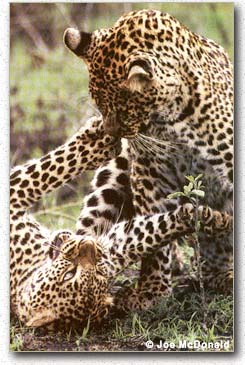the Leopard
panthera pardus
Adaptation

Due to the ever increasing population of humans and the
impact they have had on the environment as well as the leopard
directly, the leopard is considered an endangered species throughout much
of its territory. Leopards have long been hunted for their
beautiful coats, and are also often killed by villagers as they
are considered to be pests to livestock and also dangerous to
humans. Leopard populations are being killed off and driven out
of their natural habitat by humans and must continue to find new
territory and acclimate themselves to different conditions.

The leopard has adapted to many different
climate conditions, and physical adaptations are most obvious in
their coats. For example, the shade of the leopard's coat can
range from a light buff color in dryer climates to a darker
golden in more heavily forrested habitats. Melanistic
morphs, or black panthers, are usually found to be more
prevalent in the rainforest.
The leopard's coat also shows adaptations to its habitat in the
shape of its rosettes. In Africa, they are typically more
circular in the eastern areas and square in the southern
habitats.
Leopards have also developed strong, stocky legs that make them
the strongest and most efficient climbers of all the large cat
species. This is primarily beneficial for protecting the
leopards' kill from other cats such as
lions.